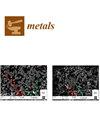The Effect of the Forming Mode on Twinning and Springback in the Bending-Dominated Forming of Magnesium AZ31 Sheet
IF 2.5
3区 材料科学
Q3 MATERIALS SCIENCE, MULTIDISCIPLINARY
引用次数: 0
Abstract
The sheet metal forming of magnesium is challenging due to the material’s complex springback behaviour, which is due to the tension/compression yield mismatch. In this study, three different AZ31 grain sizes are produced by a special heat treatment, while maintaining the material strength in uniaxial tension at a similar level. Pure, V-die and channel bending tests are combined with roll forming to compare bending scenarios with and without tension applied transverse and parallel to the bending axis. This is complemented with electron backscatter diffraction to measure the twinning type and twinning area fraction (TAF) in the tension and compression bending zones. Our study shows that, like conventional steel, when bending magnesium, springback reduces with the increasing level of the outer fibre bending strain, i.e., when the bend radius is decreased and the TAF increased. It is further shown that when tension is applied, the TAF increases. However, while in some forming cases, the increase in TAF leads to a clear reduction in springback, in other forming cases the effect of the TAF on springback is less pronounced. Overall, this study provides clear evidence that the twinning behaviour in bending magnesium is influenced by the bend deformation mode and that this influences the springback behaviour.镁 AZ31 板材弯曲成形中成形模式对孪晶和回弹的影响
由于镁材料具有复杂的回弹特性,拉伸/压缩屈服不匹配导致了镁板材成型的挑战性。在这项研究中,通过特殊热处理产生了三种不同的 AZ31 晶粒大小,同时将材料的单轴拉伸强度保持在相似水平。纯弯曲试验、V 形模具弯曲试验和槽形弯曲试验与滚压成形相结合,对弯曲轴横向和平行施加拉力和不施加拉力时的弯曲情况进行比较。此外,还辅以电子反向散射衍射法测量拉伸和压缩弯曲区域的孪生类型和孪生面积分数(TAF)。我们的研究表明,与传统钢材一样,当弯曲镁合金时,回弹会随着外层纤维弯曲应力的增加而减少,即当弯曲半径减小、TAF 增加时。进一步表明,当施加拉力时,TAF 会增加。然而,在某些成形情况下,TAF 的增加会导致回弹明显减少,但在其他成形情况下,TAF 对回弹的影响并不明显。总之,这项研究提供了明确的证据,证明镁弯曲时的孪生行为受弯曲变形模式的影响,而这又影响回弹行为。
本文章由计算机程序翻译,如有差异,请以英文原文为准。
求助全文
约1分钟内获得全文
求助全文
来源期刊

Metals
MATERIALS SCIENCE, MULTIDISCIPLINARY-METALLURGY & METALLURGICAL ENGINEERING
CiteScore
4.90
自引率
13.80%
发文量
1832
审稿时长
1.5 months
期刊介绍:
Metals (ISSN 2075-4701) is an open access journal of related scientific research and technology development. It publishes reviews, regular research papers (articles) and short communications. Our aim is to encourage scientists to publish their experimental and theoretical results in as much detail as possible. Therefore, there is no restriction on the length of the papers. The full experimental details must be provided so that the results can be reproduced. Metals provides a forum for publishing papers which advance the in-depth understanding of the relationship between the structure, the properties or the functions of all kinds of metals.
 求助内容:
求助内容: 应助结果提醒方式:
应助结果提醒方式:


